Inhibition of poly(ADP-ribose) polymerase 1 protects against acute myeloid leukemia by suppressing the myeloproliferative leukemia virus oncogene
- PMID: 26314963
- PMCID: PMC4695004
- DOI: 10.18632/oncotarget.4748
Inhibition of poly(ADP-ribose) polymerase 1 protects against acute myeloid leukemia by suppressing the myeloproliferative leukemia virus oncogene
Abstract
An abnormal expression of poly(ADP-ribose) polymerase 1 (PARP-1) has been described in many tumors. PARP-1 promotes tumorigenesis and cancer progression by acting on different molecular pathways. PARP-1 inhibitors can be used with radiotherapy or chemotherapy to enhance the susceptibility of tumor cells to the treatment. However, the specific mechanism of PARP-1 in acute myeloid leukemia (AML) remains unknown. Our study showed that expression of PARP-1 was upregulated in AML patients. PARP-1 inhibition slowed AML cell proliferation, arrested the cell cycle, induced apoptosis in vitro and improved AML prognosis in vivo. Mechanistically, microarray assay of AML cells with loss of PARP-1 function revealed that the myeloproliferative leukemia virus oncogene (MPL) was significantly downregulated. In human AML samples, MPL expression was increased, and gain-of-function and loss-of-function analysis demonstrated that MPL promoted cell growth. Moreover, PARP-1 and MPL expression were positively correlated in AML samples, and their overexpression was associated with an unfavorable prognosis. Furthermore, PARP-1 and MPL consistently acted on Akt and ERK1/2 pathways, and the anti-proliferative and pro-apoptotic function observed with PARP-1 inhibition were reversed in part via MPL activation upon thrombopoietin stimulation or gene overexpression. These data highlight the important function of PARP-1 in the progression of AML, which suggest PARP-1 as a potential target for AML treatment.
Keywords: MPL; PARP-1; acute myeloid leukemia; prognosis.
Conflict of interest statement
The authors declare no competing financial interests.
Figures

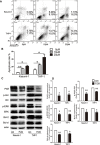
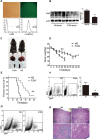
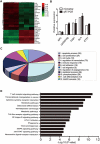
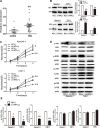

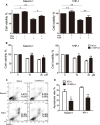

Similar articles
-
Thrombopoietin/MPL participates in initiating and maintaining RUNX1-ETO acute myeloid leukemia via PI3K/AKT signaling.Blood. 2012 Jul 26;120(4):868-79. doi: 10.1182/blood-2012-03-414649. Epub 2012 May 21. Blood. 2012. PMID: 22613795 Free PMC article.
-
High PARP-1 expression predicts poor survival in acute myeloid leukemia and PARP-1 inhibitor and SAHA-bendamustine hybrid inhibitor combination treatment synergistically enhances anti-tumor effects.EBioMedicine. 2018 Dec;38:47-56. doi: 10.1016/j.ebiom.2018.11.025. Epub 2018 Nov 22. EBioMedicine. 2018. PMID: 30472087 Free PMC article.
-
Poly(ADP-ribose) polymerase inhibitors activate the p53 signaling pathway in neural stem/progenitor cells.BMC Neurosci. 2017 Jan 17;18(1):14. doi: 10.1186/s12868-016-0333-0. BMC Neurosci. 2017. PMID: 28095779 Free PMC article.
-
Thrombopoietin: expression of its receptor MPL and proliferative effects on leukemic cells.Leukemia. 1996 Sep;10(9):1405-21. Leukemia. 1996. PMID: 8751457 Review.
-
PARP goes the weasel! Emerging role of PARP inhibitors in acute leukemias.Blood Rev. 2021 Jan;45:100696. doi: 10.1016/j.blre.2020.100696. Epub 2020 May 7. Blood Rev. 2021. PMID: 32482307 Free PMC article. Review.
Cited by
-
The Association between PARP1 and LIG3 Expression Levels and Chromosomal Translocations in Acute Myeloid Leukemia Patients.Cell J. 2018 Jul;20(2):204-210. doi: 10.22074/cellj.2018.5210. Epub 2018 Mar 18. Cell J. 2018. PMID: 29633598 Free PMC article.
-
PARP1 as a therapeutic target in acute myeloid leukemia and myelodysplastic syndrome.Blood Adv. 2021 Nov 23;5(22):4794-4805. doi: 10.1182/bloodadvances.2021004638. Blood Adv. 2021. PMID: 34529761 Free PMC article. Review.
-
Cytotoxicity and Differentiating Effect of the Poly(ADP-Ribose) Polymerase Inhibitor Olaparib in Myelodysplastic Syndromes.Cancers (Basel). 2019 Sep 16;11(9):1373. doi: 10.3390/cancers11091373. Cancers (Basel). 2019. PMID: 31527467 Free PMC article.
-
Knockdown of PARP-1 Inhibits Proliferation and ERK Signals, Increasing Drug Sensitivity in Osteosarcoma U2OS Cells.Oncol Res. 2016;24(4):279-86. doi: 10.3727/096504016X14666990347554. Oncol Res. 2016. PMID: 27656839 Free PMC article.
-
Machine learning-based bulk RNA analysis reveals a prognostic signature of 13 cell death patterns and potential therapeutic target of SMAD3 in acute myeloid leukemia.BMC Cancer. 2025 Feb 15;25(1):273. doi: 10.1186/s12885-025-13658-3. BMC Cancer. 2025. PMID: 39955536 Free PMC article.
References
-
- Daver N, Cortes J. Molecular targeted therapy in acute myeloid leukemia. Hematology. 2012;17:S59–62. - PubMed
-
- Schreiber V, Dantzer F, Ame JC, de Murcia G. Poly(ADP-ribose): novel functions for an old molecule. Nat Rev Mol Cell Biol. 2006;7:517–528. - PubMed
-
- Kraus WL, Hottiger MO. PARP-1 and gene regulation: progress and puzzles. Mol Aspects Med. 2013;34:1109–1123. - PubMed
-
- Pleschke JM, Kleczkowska HE, Strohm M, Althaus FR. Poly(ADP-ribose) binds to specific domains in DNA damage checkpoint proteins. J Biol Chem. 2000;275:40974–40980. - PubMed
Publication types
MeSH terms
Substances
LinkOut - more resources
Full Text Sources
Other Literature Sources
Medical
Molecular Biology Databases
Miscellaneous

